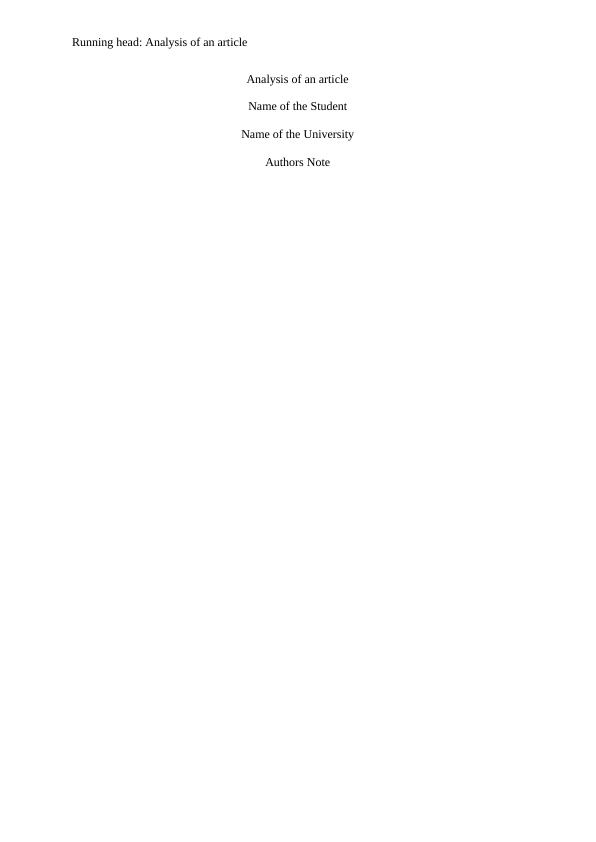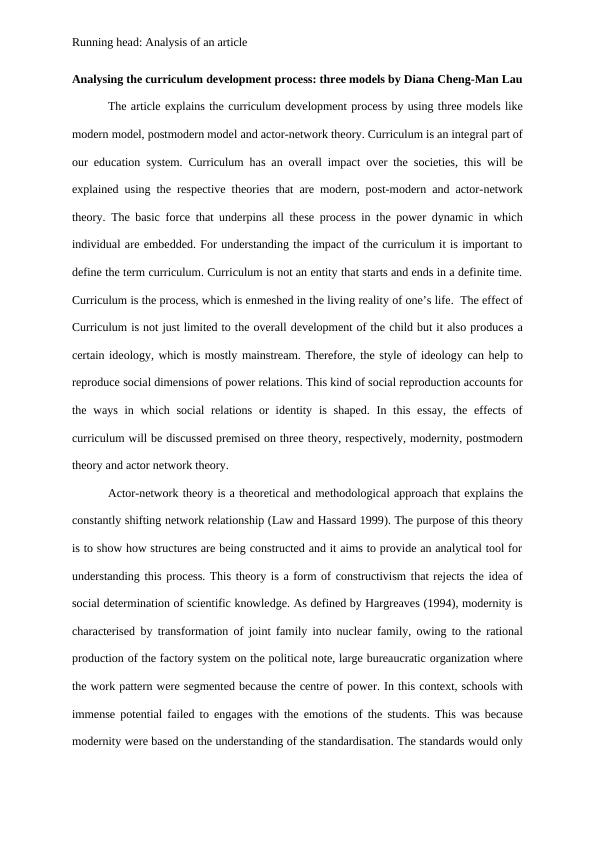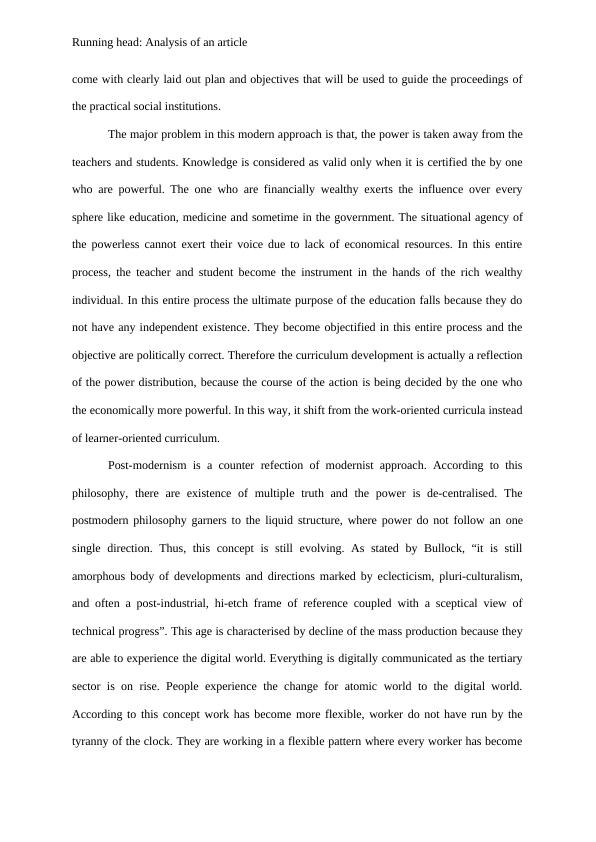Analysis of an article
7 Pages2280 Words75 Views
Added on 2023-01-23
About This Document
The article explains the curriculum development process by using three models like modern model, postmodern model and actor-network theory.
Analysis of an article
Added on 2023-01-23
ShareRelated Documents
Running head: Analysis of an article
Analysis of an article
Name of the Student
Name of the University
Authors Note
Analysis of an article
Name of the Student
Name of the University
Authors Note

Running head: Analysis of an article
Analysing the curriculum development process: three models by Diana Cheng-Man Lau
The article explains the curriculum development process by using three models like
modern model, postmodern model and actor-network theory. Curriculum is an integral part of
our education system. Curriculum has an overall impact over the societies, this will be
explained using the respective theories that are modern, post-modern and actor-network
theory. The basic force that underpins all these process in the power dynamic in which
individual are embedded. For understanding the impact of the curriculum it is important to
define the term curriculum. Curriculum is not an entity that starts and ends in a definite time.
Curriculum is the process, which is enmeshed in the living reality of one’s life. The effect of
Curriculum is not just limited to the overall development of the child but it also produces a
certain ideology, which is mostly mainstream. Therefore, the style of ideology can help to
reproduce social dimensions of power relations. This kind of social reproduction accounts for
the ways in which social relations or identity is shaped. In this essay, the effects of
curriculum will be discussed premised on three theory, respectively, modernity, postmodern
theory and actor network theory.
Actor-network theory is a theoretical and methodological approach that explains the
constantly shifting network relationship (Law and Hassard 1999). The purpose of this theory
is to show how structures are being constructed and it aims to provide an analytical tool for
understanding this process. This theory is a form of constructivism that rejects the idea of
social determination of scientific knowledge. As defined by Hargreaves (1994), modernity is
characterised by transformation of joint family into nuclear family, owing to the rational
production of the factory system on the political note, large bureaucratic organization where
the work pattern were segmented because the centre of power. In this context, schools with
immense potential failed to engages with the emotions of the students. This was because
modernity were based on the understanding of the standardisation. The standards would only
Analysing the curriculum development process: three models by Diana Cheng-Man Lau
The article explains the curriculum development process by using three models like
modern model, postmodern model and actor-network theory. Curriculum is an integral part of
our education system. Curriculum has an overall impact over the societies, this will be
explained using the respective theories that are modern, post-modern and actor-network
theory. The basic force that underpins all these process in the power dynamic in which
individual are embedded. For understanding the impact of the curriculum it is important to
define the term curriculum. Curriculum is not an entity that starts and ends in a definite time.
Curriculum is the process, which is enmeshed in the living reality of one’s life. The effect of
Curriculum is not just limited to the overall development of the child but it also produces a
certain ideology, which is mostly mainstream. Therefore, the style of ideology can help to
reproduce social dimensions of power relations. This kind of social reproduction accounts for
the ways in which social relations or identity is shaped. In this essay, the effects of
curriculum will be discussed premised on three theory, respectively, modernity, postmodern
theory and actor network theory.
Actor-network theory is a theoretical and methodological approach that explains the
constantly shifting network relationship (Law and Hassard 1999). The purpose of this theory
is to show how structures are being constructed and it aims to provide an analytical tool for
understanding this process. This theory is a form of constructivism that rejects the idea of
social determination of scientific knowledge. As defined by Hargreaves (1994), modernity is
characterised by transformation of joint family into nuclear family, owing to the rational
production of the factory system on the political note, large bureaucratic organization where
the work pattern were segmented because the centre of power. In this context, schools with
immense potential failed to engages with the emotions of the students. This was because
modernity were based on the understanding of the standardisation. The standards would only

Running head: Analysis of an article
come with clearly laid out plan and objectives that will be used to guide the proceedings of
the practical social institutions.
The major problem in this modern approach is that, the power is taken away from the
teachers and students. Knowledge is considered as valid only when it is certified the by one
who are powerful. The one who are financially wealthy exerts the influence over every
sphere like education, medicine and sometime in the government. The situational agency of
the powerless cannot exert their voice due to lack of economical resources. In this entire
process, the teacher and student become the instrument in the hands of the rich wealthy
individual. In this entire process the ultimate purpose of the education falls because they do
not have any independent existence. They become objectified in this entire process and the
objective are politically correct. Therefore the curriculum development is actually a reflection
of the power distribution, because the course of the action is being decided by the one who
the economically more powerful. In this way, it shift from the work-oriented curricula instead
of learner-oriented curriculum.
Post-modernism is a counter refection of modernist approach. According to this
philosophy, there are existence of multiple truth and the power is de-centralised. The
postmodern philosophy garners to the liquid structure, where power do not follow an one
single direction. Thus, this concept is still evolving. As stated by Bullock, “it is still
amorphous body of developments and directions marked by eclecticism, pluri-culturalism,
and often a post-industrial, hi-etch frame of reference coupled with a sceptical view of
technical progress”. This age is characterised by decline of the mass production because they
are able to experience the digital world. Everything is digitally communicated as the tertiary
sector is on rise. People experience the change for atomic world to the digital world.
According to this concept work has become more flexible, worker do not have run by the
tyranny of the clock. They are working in a flexible pattern where every worker has become
come with clearly laid out plan and objectives that will be used to guide the proceedings of
the practical social institutions.
The major problem in this modern approach is that, the power is taken away from the
teachers and students. Knowledge is considered as valid only when it is certified the by one
who are powerful. The one who are financially wealthy exerts the influence over every
sphere like education, medicine and sometime in the government. The situational agency of
the powerless cannot exert their voice due to lack of economical resources. In this entire
process, the teacher and student become the instrument in the hands of the rich wealthy
individual. In this entire process the ultimate purpose of the education falls because they do
not have any independent existence. They become objectified in this entire process and the
objective are politically correct. Therefore the curriculum development is actually a reflection
of the power distribution, because the course of the action is being decided by the one who
the economically more powerful. In this way, it shift from the work-oriented curricula instead
of learner-oriented curriculum.
Post-modernism is a counter refection of modernist approach. According to this
philosophy, there are existence of multiple truth and the power is de-centralised. The
postmodern philosophy garners to the liquid structure, where power do not follow an one
single direction. Thus, this concept is still evolving. As stated by Bullock, “it is still
amorphous body of developments and directions marked by eclecticism, pluri-culturalism,
and often a post-industrial, hi-etch frame of reference coupled with a sceptical view of
technical progress”. This age is characterised by decline of the mass production because they
are able to experience the digital world. Everything is digitally communicated as the tertiary
sector is on rise. People experience the change for atomic world to the digital world.
According to this concept work has become more flexible, worker do not have run by the
tyranny of the clock. They are working in a flexible pattern where every worker has become

End of preview
Want to access all the pages? Upload your documents or become a member.
Related Documents
Report on Curriculum Design of Biologylg...
|6
|1222
|83
Curriculum Development for Reception Teachers in Primary Schoolslg...
|7
|1337
|131
Contribution of HR Theorieslg...
|13
|4030
|47
Theories, Principles and Models in Education and Traininglg...
|23
|2245
|459
Impact of Social Media on Consumer Buying Behaviourlg...
|12
|3380
|371
Learning Disabilities in Students: Journal Article Analysislg...
|6
|1253
|321
